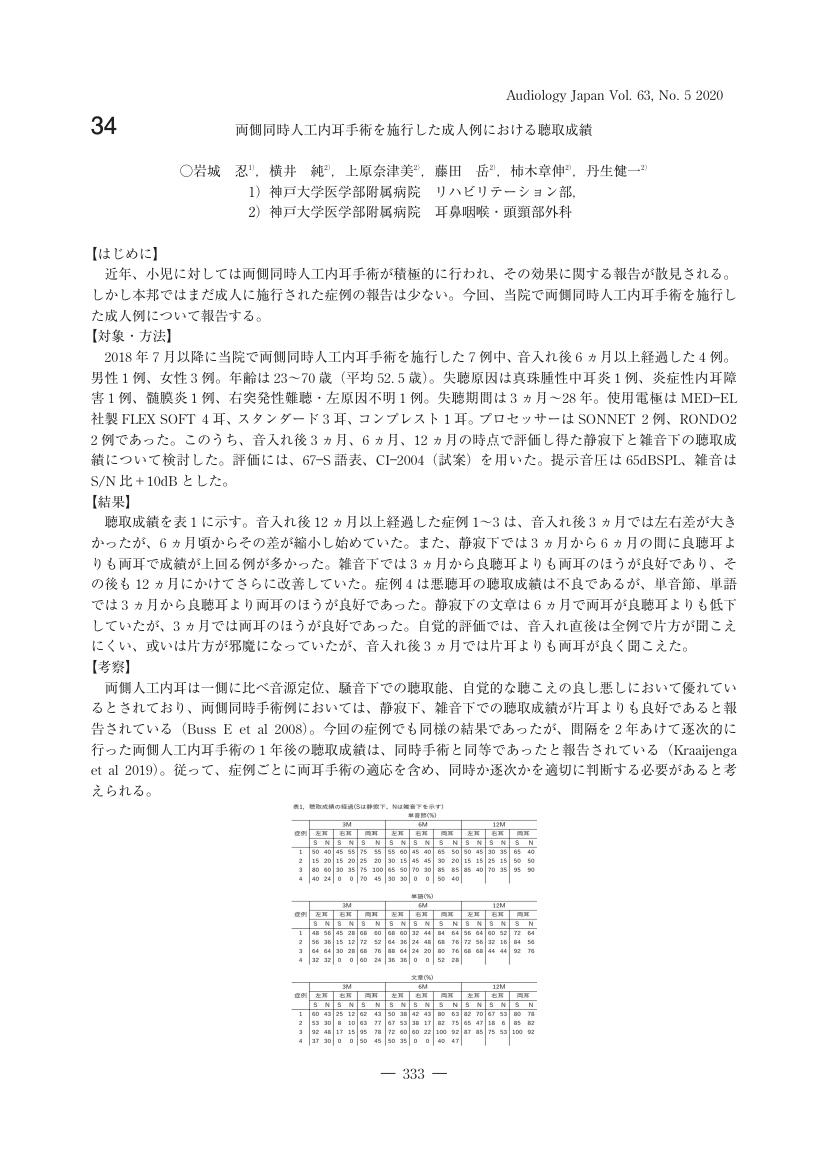6 0 0 0 OA 外耳道癌と耳かき頻度の相関性の検討
- 著者
- 石浦 良平 飯田 拓也 柿木 章伸 安藤 瑞生 吉田 昌史 齊藤 祐毅 山岨 達也 光嶋 勲
- 出版者
- 日本頭頸部癌学会
- 雑誌
- 頭頸部癌 (ISSN:13495747)
- 巻号頁・発行日
- vol.43, no.1, pp.76-78, 2017-04-25 (Released:2017-06-16)
- 参考文献数
- 7
外耳道癌は稀かつ予後不良な疾患である。その危険因子として過剰な耳かきが臨床上推測されているが,統計学的に検討した報告は少ない。今回,我々は当科で加療を行った外耳道癌患者14例を対象とし年齢,性別,耳かき頻度,耳かきに使用する道具の材質,罹患側,病理組織について検討した。また,本研究に同意を得た健常人69名を対象とし,年齢,性別,耳かき頻度,耳かきに使用する道具の材質について調査し患者群と比較検討した。その結果,50歳未満の若年群における患者群と健常人群間において,有意に耳かき頻度,および硬質素材を用いる率が高かった。今回の結果から,過剰な刺激の耳かきが外耳道癌発生を誘発する可能性が示唆された。
3 0 0 0 OA 難聴患者における次世代シークエンサーによるエクソーム解析
- 著者
- 坂田 阿希 樫尾 明憲 狩野 章太郎 柿木 章伸 尾形 エリカ 赤松 裕介 山岨 達也
- 出版者
- 日本聴覚医学会
- 雑誌
- AUDIOLOGY JAPAN (ISSN:03038106)
- 巻号頁・発行日
- vol.58, no.5, pp.491-492, 2015-09-30 (Released:2016-02-04)
2 0 0 0 OA 耳科手術支援ロボットの開発
- 著者
- 藤田 岳 上原 奈津美 山下 俊彦 西川 敦 河合 俊和 鈴木 寿 横井 純 柿木 章伸 丹生 健一
- 出版者
- 一般社団法人 日本耳鼻咽喉科頭頸部外科学会
- 雑誌
- 日本耳鼻咽喉科頭頸部外科学会会報 (ISSN:24365793)
- 巻号頁・発行日
- vol.126, no.3, pp.181-184, 2023-03-20 (Released:2023-04-01)
- 参考文献数
- 12
頭頸部外科領域にロボット手術が保険適応となり, 耳鼻咽喉科医にとってもロボット手術は身近な存在となってきた. しかし泌尿器・消化器領域で発展してきた手術ロボットを, そのまま耳や鼻の手術に応用することはまだ難しい. 私達は経外耳道的内視鏡下耳科手術 (Trans-canal Endoscopic Ear Surgery : TEES) を支援するロボットの研究・開発を複数の大学の工学部と共同で行っている. 手術ロボットの研究を通して, 自分たちの手術の特徴や問題点を改めて見直す機会が得られている. 本稿では, これまでの耳科手術用ロボットや内視鏡保持ロボットについて概略を述べ, 現在研究中の TEES 支援ロボットのコンセプトと試作機について述べる. また, 将来ロボット自身が自律的に手術を行うことを目標とした, ロボットの自律レベル向上に向けた研究についても紹介する.
2 0 0 0 OA 高周波帯域の感音難聴患者における日本語単音節の弁別能
1 0 0 0 OA 内リンパ水腫形成における抗利尿ホルモンと水チャネルの役割
- 著者
- 柿木 章伸
- 出版者
- 一般社団法人 日本めまい平衡医学会
- 雑誌
- Equilibrium Research (ISSN:03855716)
- 巻号頁・発行日
- vol.72, no.4, pp.274-279, 2013-08-31 (Released:2013-10-01)
- 参考文献数
- 24
- 被引用文献数
- 3 1
A histopathological feature of Meniere's disease is endolymphatic hydrops. Furthermore, a human temporal bone study has revealed that the endolymphatic sac showed fibrosis and/or hypoplasia in a patient with Meniere's disease. Based on this histological finding, malfunction of the endolymphatic sac may cause endolymphatic hydrops. However, it is impossible to explain the fluctuation of Meniere's symptoms with this retention hydrops, so the mechanisms underlying the endolymphatic hydrops of Meniere's diseases is still unclear. Clinically, it is well known that stress aggravates the condition of Meniere's disease. It seems to be that there are some relationships between stress and endolymphatic hydrops. Endolymphatic hydrops could be taken as malfunction of water homeostasis in the inner ear. If this is the case, one of stress hormones, vasopressin, could regulate water homeostasis in the inner ear. Actually, plasma vasopressin levels have been reported as elevated in patients with endolymphatic hydrops including Meniere's disease. Experimentally, vasopressin type 2 receptor was expressed in the basal cell of the stria vascularis. Moreover, the water channel of aquaporin (AQP) 2, the relocalization of which is regulated by vasopressin, was also expressed in the stria vascularis. Further, other AQPs were also expressed in the stria vascularis. To investigate the effect of vasopressin on the inner ear, vasopressin was administered to rats or guinea pigs. Vasopressin induced enlargement of the intrastrial space and endolymphatic hydrops. These results indicate that vasopressin affects the stria vascularis and endolymphatic hydrops was induced as a consequence. The following is a summary. Basically, patients with Meniere's disease have malfunction of the endolymphatic sac with retention hydrops. If the patients are under stress, the secretion of vasopressin would increase. The increase of vasopressin level causes the enlargement of the endolymphatic hydrops. These conditions may induce the symptom of Meniere's disease. Based on these clinical and experimental results, we produced a new animal model for Meniere's disease with vestibular disorder.
1 0 0 0 OA 両側同時人工内耳手術を施行した成人例における聴取成績
- 著者
- 岩城 忍 横井 純 上原 奈津美 藤田 岳 柿木 章伸 丹生 健一
- 出版者
- 一般社団法人 日本聴覚医学会
- 雑誌
- AUDIOLOGY JAPAN (ISSN:03038106)
- 巻号頁・発行日
- vol.63, no.5, pp.333, 2020-09-30 (Released:2020-11-10)
- 著者
- 竹田 泰三 柿木 章伸 竹内 俊二 齋藤 齋藤
- 出版者
- The Society of Practical Otolaryngology
- 雑誌
- 耳鼻咽喉科臨床 (ISSN:00326313)
- 巻号頁・発行日
- vol.85, no.12, pp.1893-1901, 1992
Recent advances in imaging technique, including high resolution thin section computed tomography scanning and magnetic resonance imaging (MRI), permit the easy diagnosis of congenital malformations of the osseous labyrinth, which have so far been lumped together as "Mondini dysplasia". In the present study the anatomic patterns from the radiographic appearance and the clinical manifestation were examined in 18 patients (23 ears) with radiographic abnormalities of the inner ear. The most common abnormal configuration was a large vestibule (20 of 23 ears). This anomaly of the vestibule often involved the lateral semicircular canal, revealed as a round high signal zone on T2-weighted MRI. However, a large vestibule was not always associated with an abnormal cochlea. Abnormal cochleas were found in 8 of the 20 ears with a large vestibule, and most of these 8 ears had total or profound deafness. But 4 of the 10 ears with residual hearing had low tone deafness and 6 had fluctuating hearing loss, which was frequently associated with attacks of dizziness. These clinical manifestations of Mondini dysplasia are similar to those of patients with endolymphatic hydrops.


